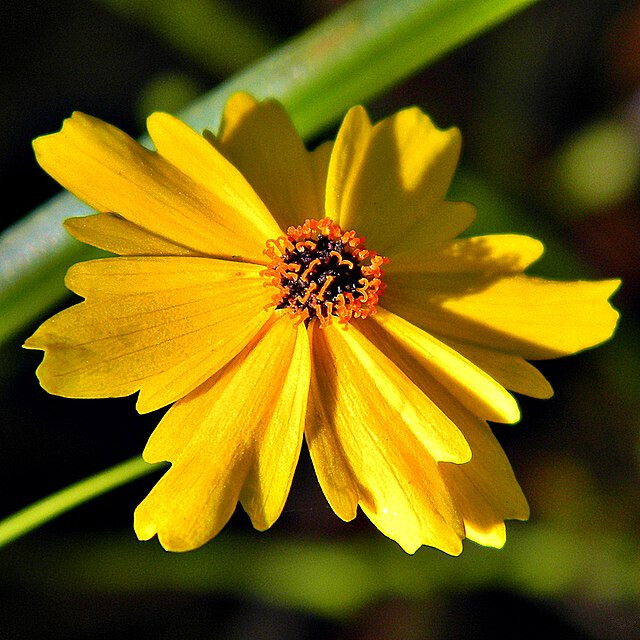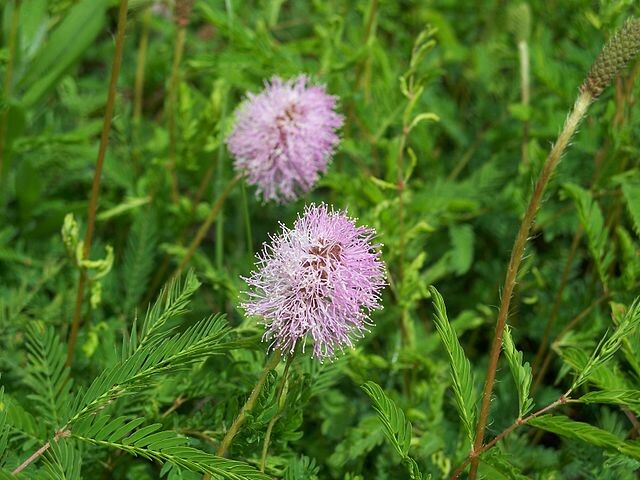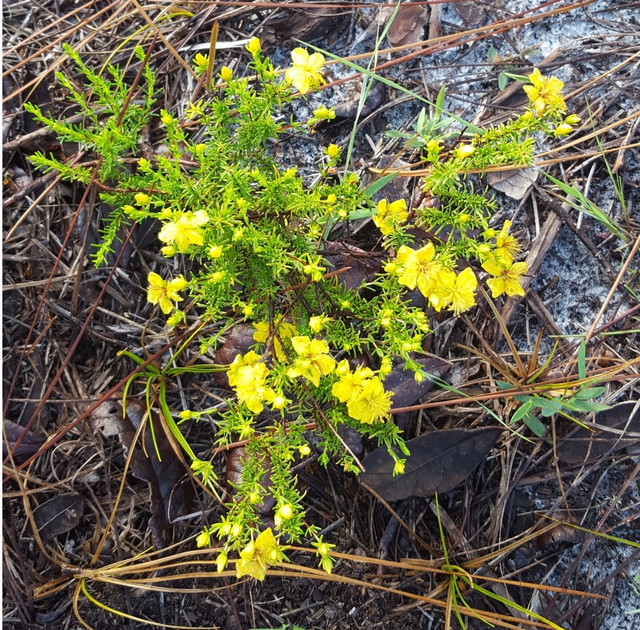Written by Don Richardson


Tropical Sage/Red Salvia (Salvia Coccinea)
Plant Type | Perennial Herb |
Size | 1-3’ tall, 2’ wide |
Sun Exposure | Full sun - full shade |
Soil Type | Mostly sand – clay loam |
Soil pH | 6.1-8.5 Acidic - Alkaline |
Bloom Time | All year |
Hardiness Zones | 7b-11 Florida Native |
Moisture | Moist, well drained |
Cold/Heat | 30°F – Drought tolerant |
Pollination | Self-pollinates, reseeds easy |
Edible Plant | No |
Medicinal Plant | Yes |
Any reference to medicinal or culinary use of plants or plant parts should in no way be considered an endorsement by The Ocala Food Forest or its staff. Research is crucial in safe and proper consumption or experimentational use of any plant.
The Salvia Coccinea, or Tropical Sage plant, is a beautiful and eye-catching addition to any garden. It is a shrub-like perennial which has a wide variety of colors and blooms all year round in warmer climates. This tropical sage is perfect for gardeners who are looking to add an exotic touch to their outdoor spaces. Let’s explore why the Salvia Coccinea should be the next plant you add to your garden!
Appearance & Growth Habits
Salvia coccinea is an upright shrub that can reach 4 feet tall when mature. It has lance-shaped leaves with pointed tips and smooth edges that are olive green in color on top and purple underneath. These leaves grow directly from the stem of the plant. The stems are woody and can be either single or multi-stemmed at the base of the plant. Typically, these plants bloom throughout summer until fall and produce dark red flower spikes that are approximately 2 inches long. The flowers have two lips with four lobes each and bright yellow stamens in the center of each bloom.
Growing Requirements & Tips
Tropical sage can be grown outdoors in USDA hardiness zones 9 through 11; however, it must be brought indoors during colder months of winter if you live outside these zones. When growing outdoors, it prefers full sun to partial shade with well-drained soil types such as loamy soils or sandy soils with a neutral pH balance (6-7). It does not tolerate wet or damp soil so make sure to water adequately but not too much as this may cause root rot. Fertilize monthly with a balanced fertilizer for best blooming results throughout the season. Deadheading spent flower spikes will promote more blooms over time. Pruning should be done after flowering has completed in order to shape and maintain size control of your plants if desired.
The Salvia Coccinea is an easy plant to care for due to its low maintenance requirements. It requires regular watering during the summer months in order to keep the soil moist; however, during the winter months water needs to be reduced as this will help prevent root rot. Fertilizing every month during spring and summer with a balanced fertilizer will help promote healthy growth of this plant. Pruning can also help encourage more vigorous growth by removing dead or diseased branches as well as encouraging new flower production from dormant buds.
Attracting Wildlife
The Salvia Coccinea not only looks great in gardens but it also attracts lots of wildlife due to its flowers which produce nectar that hummingbirds love! This tropical sage plant will also attract butterflies, bees and other pollinators which helps support local ecosystems while enhancing your garden's beauty at the same time.
Conclusion:
As you can see, adding a Salvia Coccinea plant into your garden is an excellent choice no matter what type of climate you live in! With its low maintenance requirements and ability to attract wildlife with its colorful flowers, this tropical sage makes for an attractive addition that will bring joy into your outdoor spaces all year round! So don't delay - go out there and get planting today!
As you can see, adding a Salvia Coccinea plant into your garden is an excellent choice no matter what type of climate you live in! With its low maintenance requirements and ability to attract wildlife with its colorful flowers, this tropical sage makes for an attractive addition that will bring joy into your outdoor spaces all year round! So don't delay - go out there and get planting today!
Written by Don Richardson

 Tickseed (Coreopsis Leavenworthii)
Tickseed (Coreopsis Leavenworthii)Plant Type | Annual Wildflower |
Size | 1-3’ tall, 0.5-1.5” wide |
Sun Exposure | Full sun, part sun |
Soil Type | Clay, loam, sand |
Soil pH | 5.6 – 7.7 Acidic - Neutral |
Bloom Time | All year |
Hardiness Zones | 8a-11b State Wildflower |
Moisture | Moist - dry, Well drained |
Cold/Heat | 10°F – Is drought tolerant |
Pollination | Self-pollinates, self-seeds |
Edible Plant | No, but leaves for tea |
Medicinal Plant | Yes |
Any reference to medicinal or culinary use of plants or plant parts should in no way be considered an endorsement by The Ocala Food Forest or its staff. Research is crucial in safe and proper consumption or experimentational use of any plant.
Coreopsis Leavenworthii is a flowering plant native to North America. It belongs to the family Asteraceae, which includes daisies and sunflowers. This plant is commonly referred to as “Leavenworth’s Tickseed” and has many characteristics that make it a favorite of gardeners and nature lovers alike. Let’s take a look at this unique flower.
Description of the Plant
Coreopsis Leavenworthii is an herbaceous perennial plant that grows between one and two feet tall in full sun or partial shade. The leaves are lance-shaped and have toothed edges, while the flowers are small with yellow petals and brown centers. The flowers bloom from late spring through early summer, making them great for adding color to your garden during these months.
Habitat & Growing Conditions
Coreopsis Leavenworthii is found in grassy areas such as prairies, meadows, roadsides, and parks throughout much of the United States. It prefers full sun but will tolerate some shade, making it an ideal choice for gardens with partial sun exposure. The soil should be well-drained and slightly acidic; sandy soils are best for growing this species of tickseed.
It is important to note that Coreopsis Leavenworthii does not actually like direct sunlight all day long; too much sunlight can cause leaf scorch or wilting of the leaves due to drought stress. To prevent this from occurring, water plants regularly during hot summer months; mulching around plants can also help conserve moisture in the soil. Additionally, deadheading spent blooms will encourage more flowers to form throughout the season.
Uses & Benefits
This versatile flower has many uses in both gardens and wild spaces. It can be used as a ground cover or filler plant in gardens, as it will spread quickly without taking over a space completely. It is an excellent choice for landscaping projects due to its tolerance of various soil types and light levels; it also attracts bees and butterflies to your garden with its colorful blooms! so planting Coreopsis Leavenworthii in natural areas can help attract wildlife into your yard or garden. It also makes for a great cut flower when harvested at peak bloom! Furthermore, it is easy to propagate by division or seed collecting; simply collect seeds when they have ripened on the plant (usually in late summer/early fall), then sow them directly into your garden or start them indoors 4 weeks before your last frost date. Finally, it makes an attractive cut flower—simply snip off stems at their base when they are just beginning to show color!
Conclusion:
Coreopsis Leavenworthii is an easy-to-grow perennial that will add beauty to any garden or natural area with its vibrant yellow flowers. This low-maintenance flower requires little effort on your part aside from regular watering and fertilizing, but will reward you with months of flowering each year without fail! Whether planted en masse or used as an accent piece among other plants, this versatile little flower will bring life into any outdoor space — no matter how small! For those looking for an attractive yet low-maintenance addition to their landscape, Coreopsis Leavenworthii should definitely be considered!
Coreopsis Leavenworthii is an easy-to-grow perennial that will add beauty to any garden or natural area with its vibrant yellow flowers. This low-maintenance flower requires little effort on your part aside from regular watering and fertilizing, but will reward you with months of flowering each year without fail! Whether planted en masse or used as an accent piece among other plants, this versatile little flower will bring life into any outdoor space — no matter how small! For those looking for an attractive yet low-maintenance addition to their landscape, Coreopsis Leavenworthii should definitely be considered!
Written by Don Richardson

 Sunshine Mimosa (Mimosa Strigillosa)
Sunshine Mimosa (Mimosa Strigillosa)Plant Type | Perennial Ground Cover |
Size | 2-9” tall, spreads |
Sun Exposure | Full sun - part shade |
Soil Type | Prefers acidic, grows in most |
Soil pH | 6.2 – 7.1 will tolerate 4.7 |
Bloom Time | Spring, summer |
Hardiness Zones | 8a-10b (USDA) |
Moisture | Moist, Well drained, dry |
Cold/Heat | 15°F – Is drought tolerant |
Pollination | Self pollinates |
Edible Plant | No |
Medicinal Plant | Yes |
Any reference to medicinal or culinary use of plants or plant parts should in no way be considered an endorsement by The Ocala Food Forest or its staff. Research is crucial in safe and proper consumption or experimentational use of any plant.
Have you ever come across the Sunshine Mimosa plant? If not, you’re in for a treat. This vibrant and unique plant is a great addition to any garden. It has a distinct look that can bring life to any area while also adding some interesting information to your knowledge base. Let’s take a closer look at the Mimosa strigillosa, or Sunshine Mimosa plant.
Where Does it Grow?
The Sunshine Mimosa plant is native to Florida, Texas and other parts of the southern United States. It grows best in sandy soils but can handle most soil types and can thrive in full sun or partial shade. The plant has a long taproot so it requires deep planting holes when grown from seeds. When planted in well-drained soil, this perennial will easily survive droughts and occasional flooding because of its high tolerance for water levels.
What Does it Look Like?
The Sunshine Mimosa is known for its attractive fern-like leaves that are covered with fine hairs. Its leaves are divided into leaflets that can range from one to four inches in length and are arranged in pairs along its stems with each pair at an angle of 90 degrees from the next pair up or down the stem. In late spring, bright flowers will appear on this flowering shrub which will add further interest to your garden throughout the summer months until fall arrives.
How Can You Care For One?
This shrub requires minimal maintenance once it's established; however, if you wish to encourage more blooms, pruning after flowering is recommended as this will help keep the plant looking neat and tidy over time. The Sunshine mimosa is resistant to most pests but may be susceptible to mites if overwatered or kept too damp so it's important to make sure you give your plants enough space when planting them together so air can circulate freely around them all. Additionally, since they're tolerant of drought conditions, be sure not to over-water! Lastly, fertilizing once every two months with a slow-release fertilizer such as 10-10-10 will help promote healthy growth during its growing season between April - October each year.
Conclusion:
If you're looking for an interesting addition to your garden then look no further than the beautiful Sunshine mimosa! With its distinctive appearance and easy maintenance requirements this shrub will be sure to add life and color wherever it's planted! Plus, with its drought and flood tolerance qualities this makes for a perfect pick for those living in areas where rainfall amounts vary widely throughout the year! So why not give it try today? You won't regret adding this unique beauty into your garden!
If you're looking for an interesting addition to your garden then look no further than the beautiful Sunshine mimosa! With its distinctive appearance and easy maintenance requirements this shrub will be sure to add life and color wherever it's planted! Plus, with its drought and flood tolerance qualities this makes for a perfect pick for those living in areas where rainfall amounts vary widely throughout the year! So why not give it try today? You won't regret adding this unique beauty into your garden!
Written by Don Richardson


St. John’s Wort (Hypericum Tenuifolium)
Plant Type | Perennial Shrub |
Size | 1-2’ tall, 1-2’ wide |
Sun Exposure | Full sun - part shade |
Soil Type | Sand, loamy, heavy clay |
Soil pH | 4.5 – 8.5 |
Bloom Time | Most all year long |
Hardiness Zones | 7a-10a (USDA) |
Moisture | Medium, Moist, Wet |
Cold/Heat | 14°F – Is drought tolerant |
Pollination | Needs a pollinator |
Edible Plant | In tea |
Medicinal Plant | Yes |
Any reference to medicinal or culinary use of plants or plant parts should in no way be considered an endorsement by The Ocala Food Forest or its staff. Research is crucial in safe and proper consumption or experimentational use of any plant.
The Hypericum tenuifolium plant also known as St. John’s Wort is a low-growing ornamental herbaceous perennial that provides color and texture in any garden or landscape. Native to the Eastern United States, it's easy to see why this plant is a popular choice for gardeners and landscapers alike. In this blog post, we'll take a closer look at what makes this plant so special.
What Does it Look Like?
The Hypericum tenuifolium plant typically grows up to 1 foot tall and spreads up to 2 feet wide. It has glossy green foliage with small, bright yellow flowers that bloom from late spring to summer. These flowers are often fragrant, making them an attractive addition to gardens and landscapes. The foliage of this plant also turns shades of orange and red in the fall, adding another layer of interest when other plants begin to fade away.
Benefits of Growing This Plant
There are many benefits associated with growing the Hypericum tenuifolium plant in your garden or landscape. For starters, it's a low-maintenance plant that requires very little care once established. As long as you provide it with adequate sunlight and water it regularly during the growing season, this hardy little beauty will thrive in almost any setting! Additionally, its vibrant colors bring life and energy into your outdoor space while attracting pollinating insects like bees and butterflies.
Lastly, the furry leaves of this plant make it resistant to deer browsing—so if you're looking for something that won't be eaten by local wildlife then this could be a great option for you! Plus, its compact size makes it perfect for smaller spaces or containers where larger plants may not fit.
Conclusion:
If you're looking for a low-maintenance yet beautiful addition to your garden or landscape then consider planting the Hypericum tenuifolium! This hardy herbaceous perennial offers glossy green foliage with fragrant yellow blooms throughout spring and summer as well as vibrant shades of orange and red in the fall. Not only is it relatively easy to care for but its sturdy leaves also make it resistant to deer browsing so you can enjoy having it around without worrying about animals eating it away! With all these features combined, there's no reason not to add this stunning specimen into your outdoor space today!
If you're looking for a low-maintenance yet beautiful addition to your garden or landscape then consider planting the Hypericum tenuifolium! This hardy herbaceous perennial offers glossy green foliage with fragrant yellow blooms throughout spring and summer as well as vibrant shades of orange and red in the fall. Not only is it relatively easy to care for but its sturdy leaves also make it resistant to deer browsing so you can enjoy having it around without worrying about animals eating it away! With all these features combined, there's no reason not to add this stunning specimen into your outdoor space today!
Written by Don Richardson


River Oats (Chasmanthium Latifolium)
Plant Type | Perennial Grass & Grain |
Size | 2-5’ tall, 1-2’ wide |
Sun Exposure | Full sun, part shade, full shade |
Soil Type | Acidic, slightly acidic |
Soil pH | 6.0 – 8.0 |
Bloom Time | Summer - Fall |
Hardiness Zones | 4-9 (USDA) |
Moisture | Medium, Moist, Wet |
Cold/Heat | -20° above, drought tolerate |
Pollination | Self pollinates |
Edible Plant | Yes – Seeds cooked |
Medicinal Plant | No |
Any reference to medicinal or culinary use of plants or plant parts should in no way be considered an endorsement by The Ocala Food Forest or its staff. Research is crucial in safe and proper consumption or experimentational use of any plant.
Chasmanthium latifolium, also known as northern sea oats or Indian woodoats, is a perennial grass native to North America. It is a beautiful plant that produces inconspicuous greenish-white flowers in the summertime and has long, narrow leaves that turn a stunning golden yellow during autumn. It is an excellent choice for gardeners looking for a low-maintenance addition to their garden. Let's learn more about this incredible plant and what it can do for your yard.
Features and Benefits
Chasmanthium latifolium stands out among other grasses due to its unique features. It grows quickly in most soil types and can reach heights between two and four feet tall. The leaves are typically flat but can take on an arching shape when planted in dense clumps or when grown on hilly terrain. The leaves are also known for their ability to move with the slightest breeze, creating a soft rustling sound that is pleasing to the ear. This grass prefers full sun but will tolerate some shade as well, making it ideal for sunny gardens or shady corners of your yard.
The most attractive feature of Chasmanthium latifolium is its color-changing foliage. In late summer, the plant produces small panicles with inconspicuous greenish-white flowers which attract pollinators such as bees and butterflies. As fall approaches, the leaves take on a stunning golden yellow hue that adds warmth and beauty to any landscape design. This striking foliage makes it an ideal choice for gardeners who want to add interest to their gardens without having to purchase additional plants or invest in complicated maintenance routines.
Nutritional Benefits
Chasmanthium latifolium is packed with nutritious benefits. The seeds are high in protein, fiber, vitamin C and other essential nutrients. They are also low in calories and fat, making them an ideal addition to any healthy diet. Furthermore, the seeds contain powerful antioxidants that can help protect against disease and promote overall health and wellness.
These edible seeds can be found in nature or purchased from health food stores or online retailers. Once you have obtained the seeds, they should be cleaned before consumption to remove dirt or debris. To do this, place the seeds in a bowl of water and stir gently until any dirt has been removed from the surface of the seed. After cleaning them thoroughly, you can then cook them up in your favorite recipes like oatmeal. The seeds have a nutty flavor and can be used as an ingredient in salads or soups or even added to breads and muffins as an extra crunchy topping. They can also be ground into flour which can then be used to make pancakes and other baked goods. For those looking for something different they can also be roasted like pumpkin seeds for a satisfying snack
Growing Chasmanthium Latifolium
Chasmanthium latifolium is very easy to grow given the right conditions. The plant prefers moist soil with good drainage, so it should be planted in areas where rainwater can easily reach its roots without pooling or standing water accumulating around them. It does not require much fertilizer but will benefit from periodic applications of compost or mulch throughout the year. To promote healthy growth, dead foliage should be removed as needed throughout the growing season so that new shoots can flourish without competition from old growth blocking sunlight and nutrients from reaching them.
Conclusion:
Chasmanthium latifolium is an attractive and easy-to-grow perennial grass that adds beauty and texture to any landscape design. Its color changing foliage provides interest all year round while its low maintenance needs make it ideal for busy gardeners who don't have time for intensive care routines yet still want a beautiful lawn or flowerbeds filled with color and texture. Whether you are looking for something low maintenance yet eye-catching or just need something different from your standard grasses, this incredible plant could be exactly what you're looking for!
Chasmanthium latifolium is an attractive and easy-to-grow perennial grass that adds beauty and texture to any landscape design. Its color changing foliage provides interest all year round while its low maintenance needs make it ideal for busy gardeners who don't have time for intensive care routines yet still want a beautiful lawn or flowerbeds filled with color and texture. Whether you are looking for something low maintenance yet eye-catching or just need something different from your standard grasses, this incredible plant could be exactly what you're looking for!








